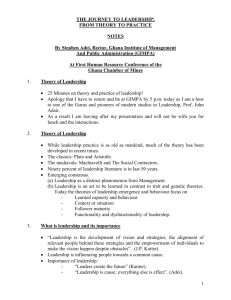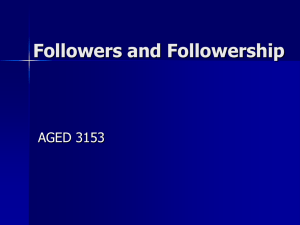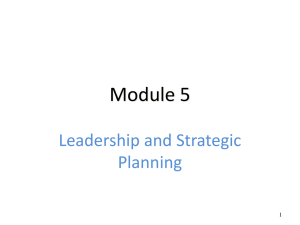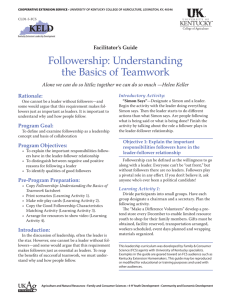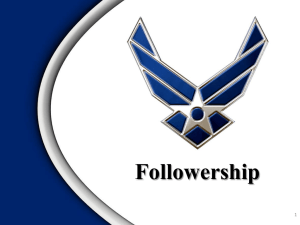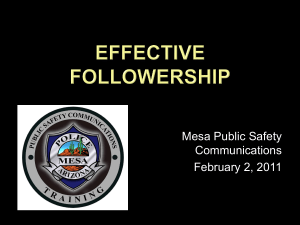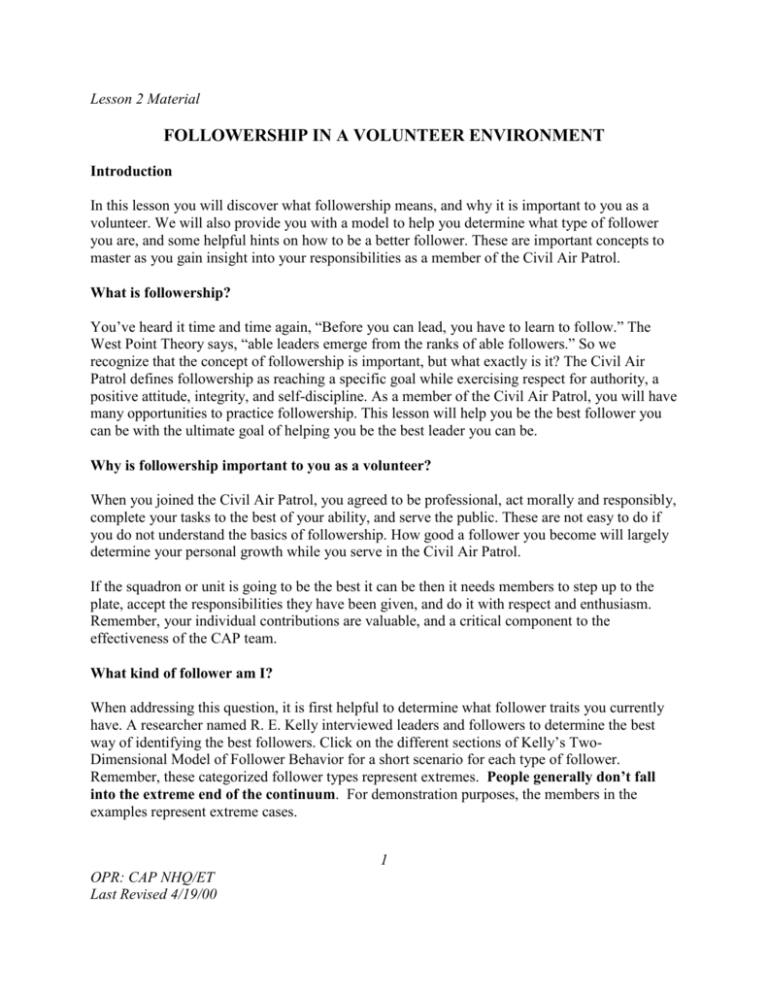
Lesson 2 Material
FOLLOWERSHIP IN A VOLUNTEER ENVIRONMENT
Introduction
In this lesson you will discover what followership means, and why it is important to you as a
volunteer. We will also provide you with a model to help you determine what type of follower
you are, and some helpful hints on how to be a better follower. These are important concepts to
master as you gain insight into your responsibilities as a member of the Civil Air Patrol.
What is followership?
You’ve heard it time and time again, “Before you can lead, you have to learn to follow.” The
West Point Theory says, “able leaders emerge from the ranks of able followers.” So we
recognize that the concept of followership is important, but what exactly is it? The Civil Air
Patrol defines followership as reaching a specific goal while exercising respect for authority, a
positive attitude, integrity, and self-discipline. As a member of the Civil Air Patrol, you will have
many opportunities to practice followership. This lesson will help you be the best follower you
can be with the ultimate goal of helping you be the best leader you can be.
Why is followership important to you as a volunteer?
When you joined the Civil Air Patrol, you agreed to be professional, act morally and responsibly,
complete your tasks to the best of your ability, and serve the public. These are not easy to do if
you do not understand the basics of followership. How good a follower you become will largely
determine your personal growth while you serve in the Civil Air Patrol.
If the squadron or unit is going to be the best it can be then it needs members to step up to the
plate, accept the responsibilities they have been given, and do it with respect and enthusiasm.
Remember, your individual contributions are valuable, and a critical component to the
effectiveness of the CAP team.
What kind of follower am I?
When addressing this question, it is first helpful to determine what follower traits you currently
have. A researcher named R. E. Kelly interviewed leaders and followers to determine the best
way of identifying the best followers. Click on the different sections of Kelly’s TwoDimensional Model of Follower Behavior for a short scenario for each type of follower.
Remember, these categorized follower types represent extremes. People generally don’t fall
into the extreme end of the continuum. For demonstration purposes, the members in the
examples represent extreme cases.
1
OPR: CAP NHQ/ET
Last Revised 4/19/00
Lesson 2 Material
Two-Dimensional Model of Follower Behavior
Independent, critical thinking
Alienated
followers
Passive
Effective
followers
Survivors
Sheep
Active
Yes people
Dependent, uncritical thinking
Reprinted by permission of Harvard Business Review. An exhibit from “In Praise of Followers” by Robert E.
Kelley, issue (November/December 1988). Copyright 1988 by the President and Fellows of Harvard College; all
rights reserved.
******************************************************
Note: These will appear as separate frames when the person clicks on one of the sections of the
Follower Model.
R. E. Kelly determined that followers ranged from independent, critical thinking at one end to
dependent, uncritical thinking on the other. He sums it up by saying, “The best followers are
individuals who ‘think for themselves,’ ‘give constructive criticism,’ ‘are their own person,’ and
are ‘innovative and creative.’ At the other end of the spectrum, the worst followers ‘must be told
what to do,’ ‘can’t make it to the bathroom on their own,’ and ‘don’t think.’ In between are the
typical followers, who ‘take direction’ and ‘don’t challenge leader or group’” (Kelley 1992).
Kelley’s second dimension ranges from active to passive, and refers to a follower’s degree of
active engagement in work. According to Kelley, “the best followers ‘take initiative,’ ‘assume
ownership,’ ‘participate actively,’ ‘are self-starters,’ and ‘go above and beyond the job.’ The
worst ones are ‘passive,’ ‘lazy,’ ‘need prodding,’ ‘require constant supervision,’ and ‘dodge
responsibility.’ In between these extremes are the typical followers who ‘get the job done
without supervision after being told what to do,’…and ‘shift with the wind’” (Kelley 1992).
2
OPR: CAP NHQ/ET
Last Revised 4/19/00
Lesson 2 Material
Cadet Ovine is a passive person. He simply does what he is told without thinking about what he
is doing. He passively complies with orders and takes no actions in support of the squadron and
its goals without being specifically told to do so. His passive personality and uncritical thinking
define him as a Sheep. Cadet Ovine is easily manipulated and pushed around, and he fails to
critically think about what he’s doing.
SM Toady is extremely active. She volunteers for everything she can. Unfortunately, she
mindlessly agrees with everything she hears from the flight leader. Cadet Toady lacks the ability
to critically appraise policies and form opinions on her own. Cadet Toady readily carries out any
and all orders. In the big picture, Toady is defined as a Yes person. In her rush to gain favor
from her superiors, she will get in trouble. She can also be easily manipulated.
Captain Rupture always has a complaint. He is an independent thinker, critical of all ideas and
policies that come down from on high. He points out every problem he can think of.
Unfortunately, he is also passive. Rupture takes no action on his own to improve the situation.
It’s easier to complain than to work to make things better. Rupture does not get along with the
rest of the flight; he is an Alienated follower. Rupture will wear down the morale of everyone
in the unit.
LtCol. Waveless has a motto, “If the minimum wasn’t good enough, it wouldn’t be the
minimum.” Waveless lives in the middle of the Follower model. He is not particularly
committed to working group goals unless it will keep him out of trouble. Waveless does not
want to stick out and therefore is a mediocre performer. On occasion, he may get up and do
something for the flight, but his motivation is to stay in the background and not get in trouble.
He offers no suggestions to the chain-of-command on his own. Waveless is known as a
Survivor.
Cadet Riprock plays an active role in the flight. He actively seeks out responsibility, and works
on his own to accomplish flight goals. When he sees something that can be improved, Riprock
critically thinks things through and offers suggestions for improvement up the chain-ofcommand. By being a critical thinker and displaying an active personality, Riprock would be
categorized as an Effective follower.
******************************************************
Ideally, we all want to be an effective follower. The challenge is to make the effort to develop
characteristics that promote followership.
Effective Followership
There are specific characteristics we can work on to become better followers. These include, but
are not limited to, being enthusiastic, being proactive, owning the territory, being versatile and
3
OPR: CAP NHQ/ET
Last Revised 4/19/00
Lesson 2 Material
flexible, avoiding the complaining trap, and practicing the CAP Core Values. These
characteristics represent only a small sample of the areas you can focus on to grow as a follower.
No one can force you to be a better follower, you must take the initiative and work at it.
******************************************************
Note: These will appear as a separate frame when the person clicks on ‘characteristics’ shown
above.
Effective Followership
Enthusiastic
Enthusiasm is a contagious energy. Once you’re assigned a task and you accomplish that task,
you will want your efforts to be accepted by the group. Your level of enthusiasm will have a
direct effect on the group or the leader’s feelings concerning the task. Display an upbeat and
energetic behavior when performing and promoting tasks. Mission accomplishment will often
rest with the followers’ enthusiasm as will as the leaders.
Proactive
Effective followers need to take a “proactive stance” toward organizational problems. Being
proactive means more than taking initiative. Our behavior is a function of our decisions, not our
conditions. We have to take the initiative and the responsibility to make things happen. This
includes building effective relationships with your supervisor. Highly proactive people
recognize the importance of accepting responsibility.
Own the territory
A proactive follower critically considers policies and actively presents suggestions up the chainof-command that will directly contribute to unit success. Making the unit better is a task that
needs to be “owned” by the followers within the individual units and squadrons.
Versatile and flexible
Beating your head against a brick wall isn’t the most efficient or effective way to get to the other
side. A better approach is to take a step back and reevaluate. A second look will usually reveal a
better way around the wall (i.e., go around it, climb over it, or dig a tunnel under it.) The point is
choosing another option is less painful than trying to break through the wall. Apply this same
principle when approaching an assigned task. Take a few minutes to reevaluate a task before
4
OPR: CAP NHQ/ET
Last Revised 4/19/00
Lesson 2 Material
wasting time and energy trying to overcome seemingly insurmountable obstacles. Use your
brain before you use your head.
The complaining trap
As an effective follower, your job is to make the squadron work in spite of good or poor
leadership. Complaining about policies and poor leadership is very easy and natural for us to do.
Think about the offshoot of your complaints. By complaining about decisions and leadership,
you undermine the chain-of-command. Instead of complaining, find creative ways to make the
situation better. Keep in mind that complainers can sink the morale in a squadron very quickly.
CAP Core Values
The CAP Core Values are the bedrock to a trusting environment. Lip service to them will do
nothing but undermine the mission of the individual units and the entire Civil Air Patrol.
Applying these values in your everyday life is a personal thing. You can’t force them on anyone,
and you’ll eventually be able to spot a fraud. Having a personal mission statement that you can
refer to throughout your life will help you incorporate these values in your lifestyle and increase
your effectiveness as a dynamic follower.
******************************************************
Conclusion
The Civil Air Patrol needs effective followers who are willing to contribute to the overall effort
of the squadron/unit. Therefore, it is important to understanding the basic principles of
followership, and apply them in all that you do. This will not only improve your working
environment, but it will make you a better person as well. Remember, the first step in becoming
a better leader is mastering the concepts of followership.
5
OPR: CAP NHQ/ET
Last Revised 4/19/00


